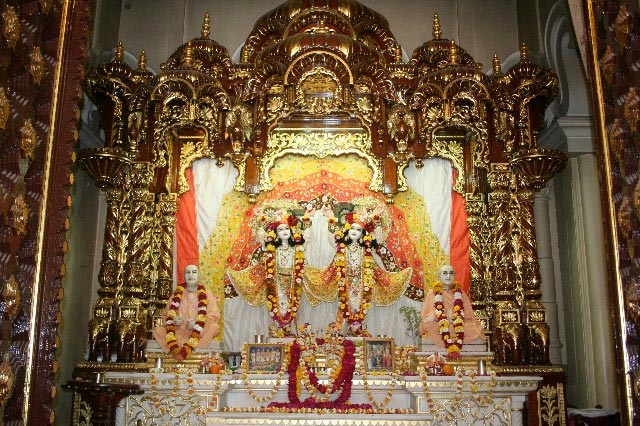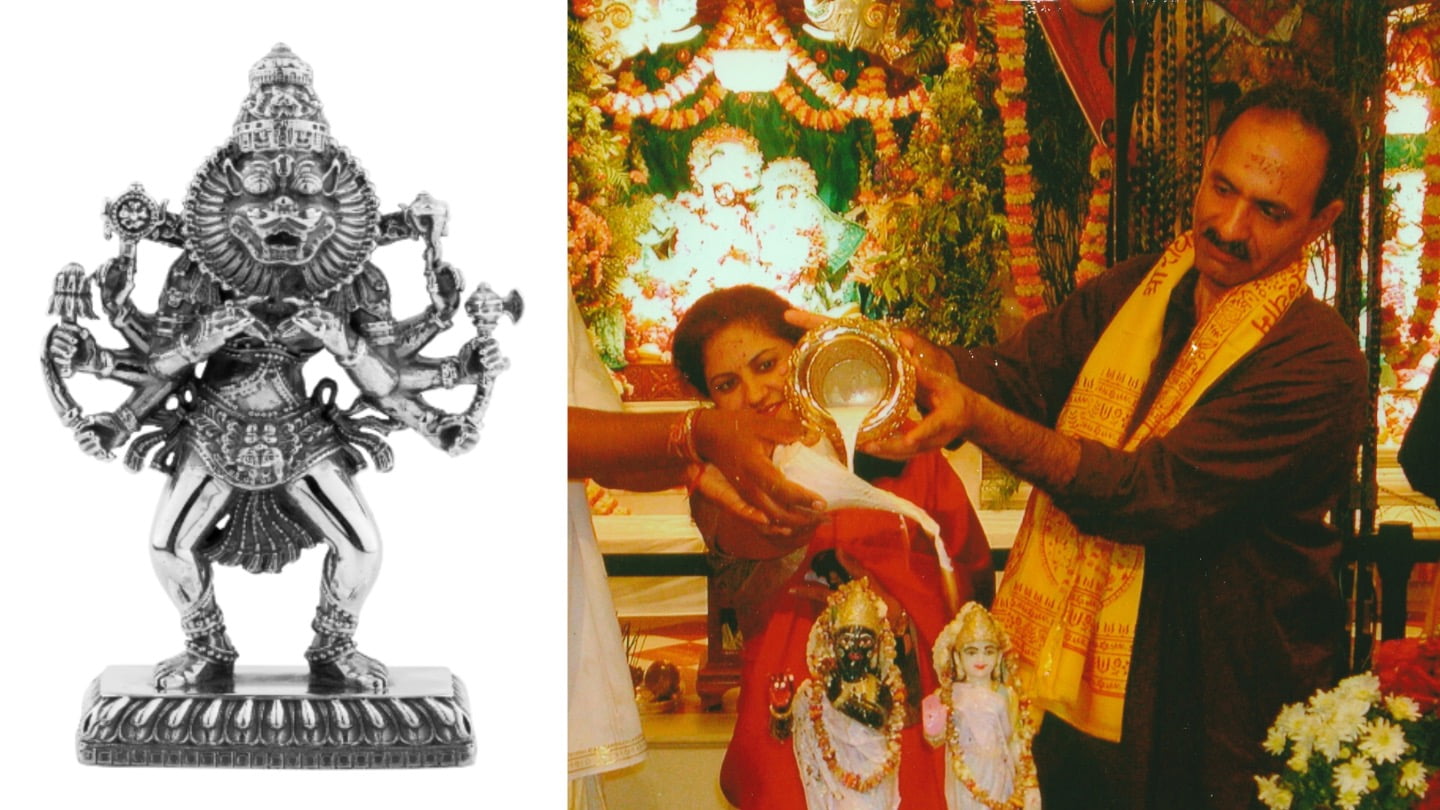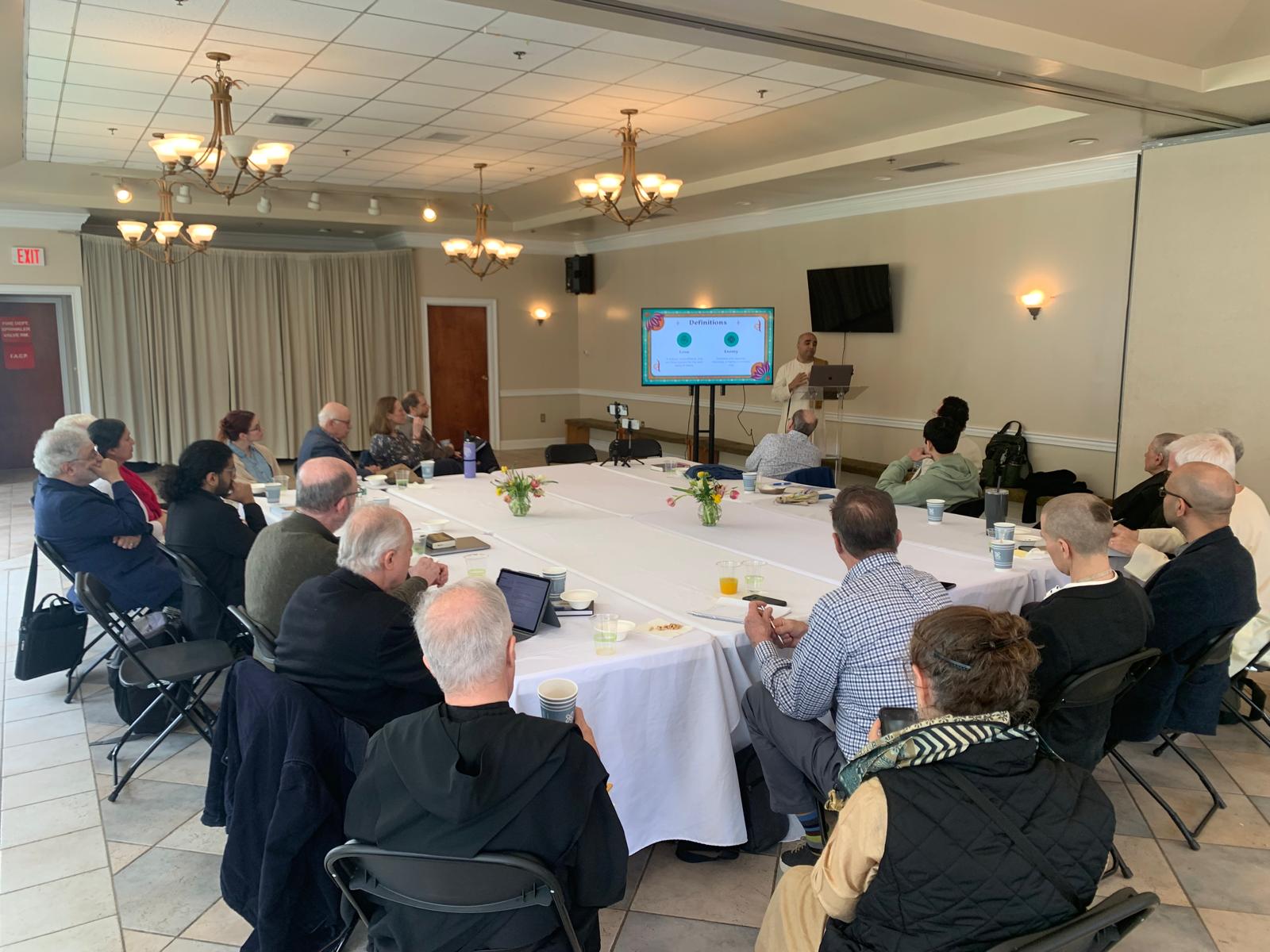Balarama’s Appearance Day Observers Pray for Spiritual Strength
By Madhava Smullen | Aug 01, 2009

Following a spiritual lifestyle requires strength. Strength to hold off the advances of a world intent on selling you products and life choices you don’t need. Strength to aspire for goals of the spirit, outside this body of flesh and blood that we inhabit. Strength to aim for a spiritual destination despite the seeming pleasures of this world. It’s hard. You know it, and I know it. Anyone who is trying to live a spiritual life knows it.
That’s why this August 5th is one of the most important festival days of the year for ISKCON devotees. For by worshiping Lord Balarama on the occasion of his appearance, they will get strength from the strongest.
Who is Balarama? According to Krishnadasa Kaviraja’s Chaitanya Charitamrita—a manual of devotion and biography of Gaudiya Vaishnavism’s founder Shri Chaitanya—he is the first expansion of God, Krishna, and assists the Lord in his pastimes. Yet while appearing to be a separate person from Krishna, Balarama is also intriguingly non-different. Chaitanya Charitamrita describes him as Krishna’s “second body,” and explains, “These two are one and the same identity. They differ only in form.”
Still, Balarama serves as Krishna’s elder brother, both in their eternal state of being in the Spiritual World, and during their recorded earthly pastimes. In a way, this gives him a senior position to God, a fascinating prospect that has an equally fascinating story behind it.
According to the ancient Puranas, each cycle of time contains four Yugas: Satya, Treta, Dvapara and Kali. As Krishna himself states in Bhagavad-gita, he appears in each of these Yugas along with his associates, “To deliver the pious and to annihilate the miscreants, as well as to reestablish the principles of religion.”
One of these appearances, during Treta Yuga, was as Lord Ramachandra. In this Avatar, Krishna was assisted by his female energy and eternal consort Radharani as Rama’s wife Sita, and Balarama as his younger brother Lakshman.
But as he carried out his mission of destroying the demon Ravana and giving the world the example of an ideal king, Rama endured untold suffering. He was banished from his inherited kingdom by his own step-mother; sent to the forest in exile for fourteen years; told that his father had died in grief while he was away; suffered the harsh austerities of life in the forest; and had his beloved wife kidnapped by Ravana.
While all these incidents were the Lord’s own decisions and integral to his example of perfect righteousness, they nevertheless caused Balarama, as Lakshman, much pain. His inferior position as younger brother did not allow him to object to Rama’s actions. The Chaitanya Charitamrita explains, “As a younger brother he could not stop Lord Rama from his resolution. And so he remained silent, although unhappy in his mind.”
Out of his love for Krishna, Balarama vowed that in future earthly advents he would never again take birth as the Lord’s younger brother. So when Krishna appeared again in Dvapara Yuga in his eternal form, Balarama became his elder brother by one year to ensure that he would be happy and not go through so many hardships.
Only 500 years ago in the current age, Kali, Balarama again appeared as the older brother—Nityananda Prabhu—to Krishna’s incarnation as Shri Chaitanya. Together, the two introduced the chanting of the Hare Krishna mantra as the best path to God and self-realization.
Often known as “Maha” or “Great,” this mantra is the very same one chanted the world over by ISKCON devotees, and has caused them to be famously dubbed “The Hare Krishnas.” Of the three names repeated in the mantra—Hare, Krishna, and Rama—Hare refers to Radharani, Krishna to the Lord, and Rama to Balarama. That Balarama’s name should appear in a mantra which ISKCON devotees chant over two thousand times daily, illustrates how important he is in Gaudiya tradition.
In fact, Balarama is known to all Gaudiya Vaishnavas as the original guru, which brings us back to the topic of spiritual strength. According to the Bhagavad-gita, one cannot approach God without the help of a guru. So the guidance of Lord Balarama is not only helpful to one’s spiritual life, but it is essential—one cannot reach Krishna without it!
“One cannot attain the goal of life without the mercy of Balarama,” states the Mundaka Upanishad emphatically. And ISKCON founder Srila Prabhupada writes, “If one has no connection with Balarama, then even though one is a very learned scholar or has taken birth in a very respectable family, these assets will not help him.”
Lord Balarama is central to Prabhupada’s advice on making spiritual progress, as he outlines in Srimad-Bhagavatam: “Jnanasim, the sword of knowledge, is given by Krishna, and when one serves the guru and Krishna in order to hold the sword of Krishna’s instructions, Balarama gives one strength. Thus one should accept the sword of knowledge from Krishna and be strong with the mercy of Balarama. We are therefore worshiping Krishna-Balarama in Vrindavana.”
There are many temples of Lord Balarama in Vrindavana, the holy town in India where Krishna is said to have appeared 5,000 years ago. One of them, Doka Dauji, sits atop Govardhana Hill and is home to a black deity of Balarama—or Dauji, “elder brother—”in a crouching position. Although Balarama normally appears white, he is said to have taken on a blackish color like Krishna’s while watching and becoming intensely absorbed in Krishna’s playful dancing pastimes. Also extremely notable is the famous Sri Dauji Mandir, established by Krishna’s great-grandson Vajranabha around 4,900 years ago. Sri Dauji, in fact, is one of the sixteen original deities that were carved under Vajranabha’s personal supervision.
But the worship Srila Prabhupada is referring to is at Krishna Balarama Mandir—of the greatest significance to ISKCON devotees because of its unique side-by-side worship of Krishna- Balarama and their Avatars Chaitanya-Nityananda.
In the 1970s, before the construction of Krishna-Balarama Mandir, Srila Prabhupada wrote in one of his purports to Chaitanya Charitamrita: “At present there are about five thousand temples in Vrindavana, and still our society, the International Society for Krishna Consciousness, is constructing a huge, magnificent temple for the worship of Lord Krishna and Lord Balarama, along with Radha-Krishna and Nitai-Gaurachandra [Shri Chaitanya].
“Since there is no prominent Krishna-Balarama temple in Vrindavana, we are attempting to construct one so that people will be attracted to Krishna-Balarama, or Nitai-Gaurachandra.
“Narottama Dasa Thakura says that Balarama and Krishna have advented themselves as Gaura-Nitai. To propagate this fundamental principle, we are establishing a Krishna-Balarama temple to broadcast to the world that worship of Gaura-Nitai is the same as worship of Krishna-Balarama.”
And indeed there is nowhere to worship Lord Balarama quite like Krishna-Balarama Mandir, where the embodiment of spiritual strength gazes down at you from an ornate altar, smiling and leaning playfully on his divine younger brother’s shoulder. This year, as the special day dawns in the quiet, early hours of August 5th, priests will offer brand new outfits of clothes to the two brothers, as well as to Radha-Krishna and Gaura-Nitai. Later, as the dawn light filters into the temple and more devotees crowd in for worship, they will offer a second new outfit. Curtains will part, and adoring devotees will see Krishna and Balarama in their full glory—and praise them with chanting and dancing.
Every year, flower and leaf festoons hanging from the ceiling and winding about the pillars of the altar add drama to the festival—but this year’s decorations promise to deliver an even stronger effect. All three deity altars, as well as the altar doors, the deities’ beds, swing and palanquins have been given special long-lasting gold-leafing treatment, adding a stunning dimension to their already intricate wooden designs.
Talks on the various wonderful stories about Lord Balarama will follow the morning chanting, after which a traditional abhisekha bathing ceremony will be held. With a variety of ingredients, including milk, yoghurt, ghee, and honey cascading over smaller forms of the large Krishna and Balarama deities, it’s a mesmerizing and devotion-inspiring spectacle.
In the evening, devotees will carry the small Krishna and Balarama forms in a procession around the temple. Hundreds of food dishes, many including honey, Balarama’s favorite, will be offered to the deities, and then served out to the gathering of devotees in a sumptuous feast.
But don’t worry—you needn’t travel as far as India in your search for spiritual strength. If the pressures of this material world are feeling heavy on your shoulders these days, just visit the ISKCON temple closest to you this August 5th and pray to Lord Balarama or his Avatar Nityananda Prabhu. Or, see the famous Krishna-Balarama Mandir deities themselves on live webcam at the Krishna.com homepage.












